Overview of Neo4j Administration
About this module
As a Neo4j database administrator, you will be responsible for ensuring that the deployed Neo4j application runs to meet the needs of its users. This includes ensuring that the Neo4j software is up-to-date and configured properly, monitoring the use of Neo4j, performing life cycle activities such as backups, and managing multiple Neo4j instances.
At the end of this module, you will be able to:
-
Describe common application architectures that use Neo4j.
-
Determine which edition of Neo4j to use.
-
Download a specific Neo4j version.
-
Determine which deployment option to use.
-
Describe the administrative tasks for Neo4j.
-
Install Neo4j Enterprise Edition.
Common application architectures with Neo4j
Neo4j can be used in a range of different application architectures. It is a transactional, real-time store for highly connected data.
Applications connect to Neo4j using the binary Bolt protocol, which is supported by the official language drivers. Currently the drivers for .NET, Java, JavaScript, Python, and Go are officially supported by Neo4j. There are also a set of other language drivers written by the Neo4j community.
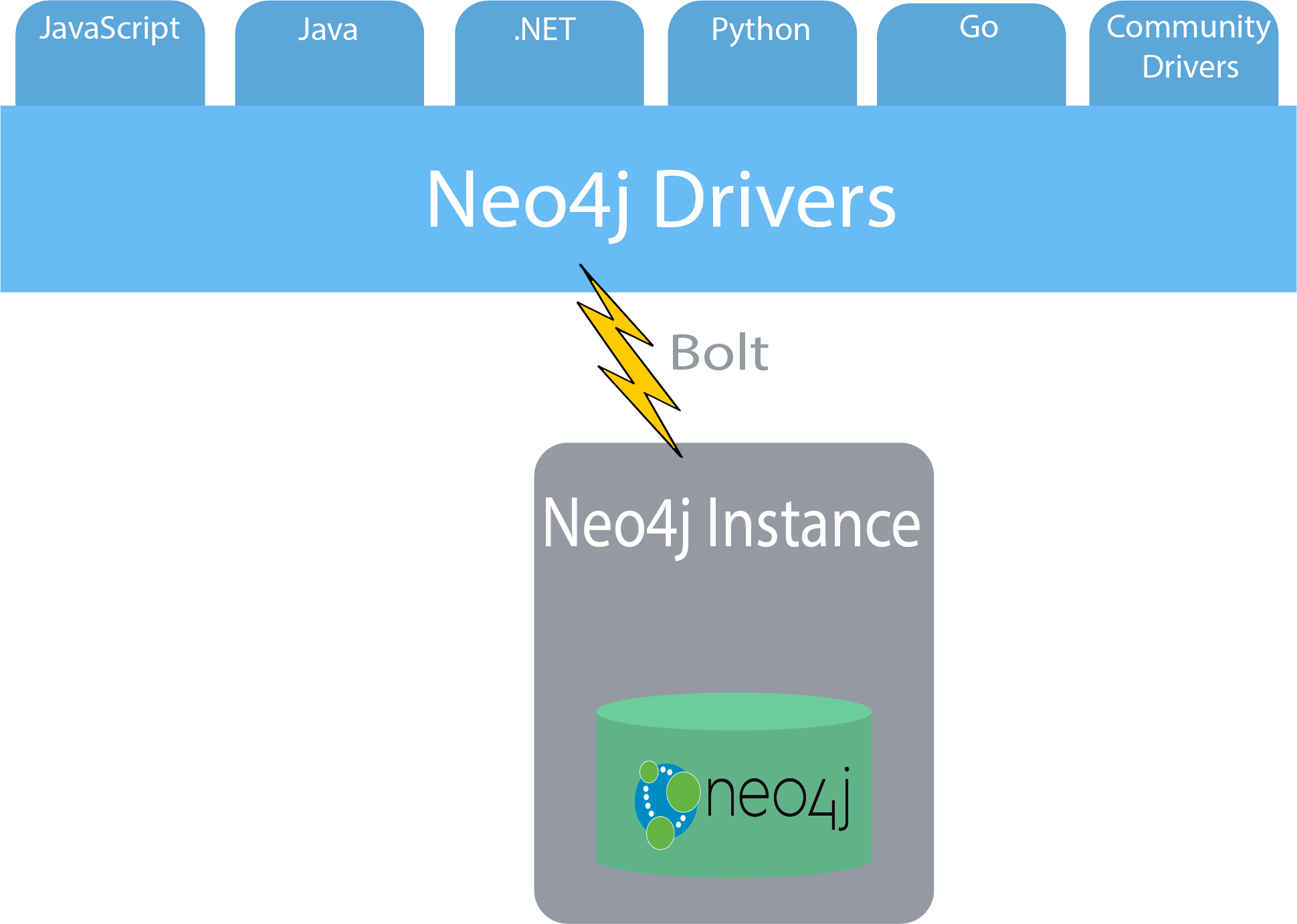
Extending Neo4j
Some applications use Neo4j out-of-the-box, and others extend it with additional functionality from libraries that provide specialized procedures. Examples of these libraries include:
-
Neo4j-supported procedures:
-
Graph Algorithms
-
GraphQL
-
-
Community-supported procedures, for example the Awesome Procedures of Cypher (APOC)
-
Custom-developed procedures for your application
Regardless of which library your application requires, you must ensure that Neo4j is configured to know how to access these libraries.
Your application will include at least one Neo4j database, but it could include multiple databases, each with their own Neo4j instance. A Neo4j instance can only support one active database.
Many deployed applications use Causal Clustering which you will learn about later in this training. Causal Clustering is an architecture which provides data safety and performance for critical systems that could be distributed all over the world.
Example architecture #1: Using Neo4j as the primary database
Some applications are developed using data that is stored in a single graph. They can be developed using any language for which there is a driver that can connect to Neo4j.
Each application (Neo4j client) communicates with Neo4j to access the graph using the Bolt or HTTP protocol. Neo4j-supported and some community drivers use the Bolt protocol. The clients can be JVMs, .NET resources, a Web server, all of which can be accessed by an end-user.
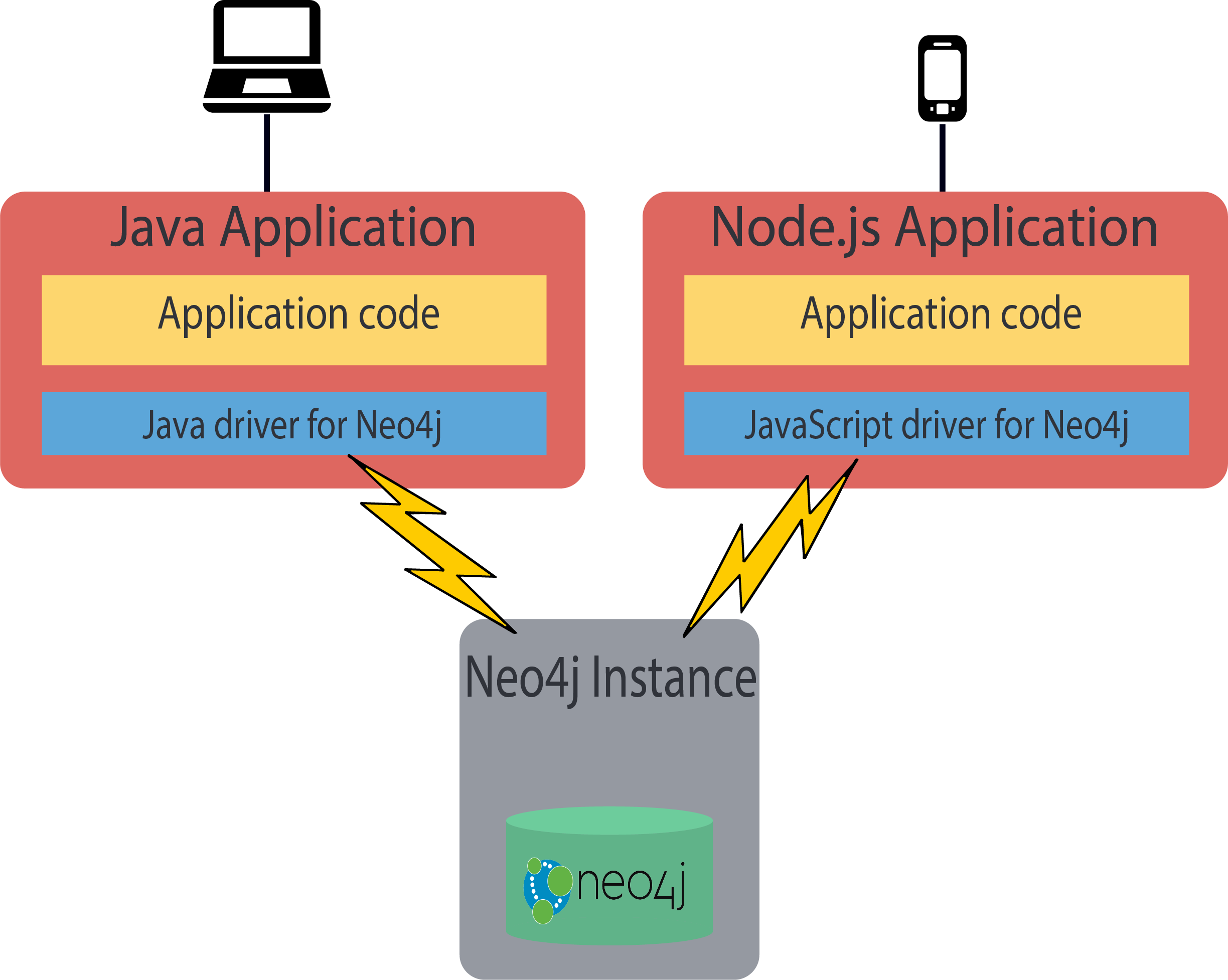
As a Neo4j database administrator, you are responsible for the availability and consistency of the Neo4j database.
Example architecture #2: Integrating Neo4j with other databases
Neo4j is often used in combination with other data sources (polyglot persistence), such as relational or NoSQL databases. Data can be fetched from the different systems in order to be manipulated by an application and subsequently written back to Neo4j. Other solutions can involve loading of data from a number of databases into Neo4j in order to efficiently do connected data analysis on the combined data set.
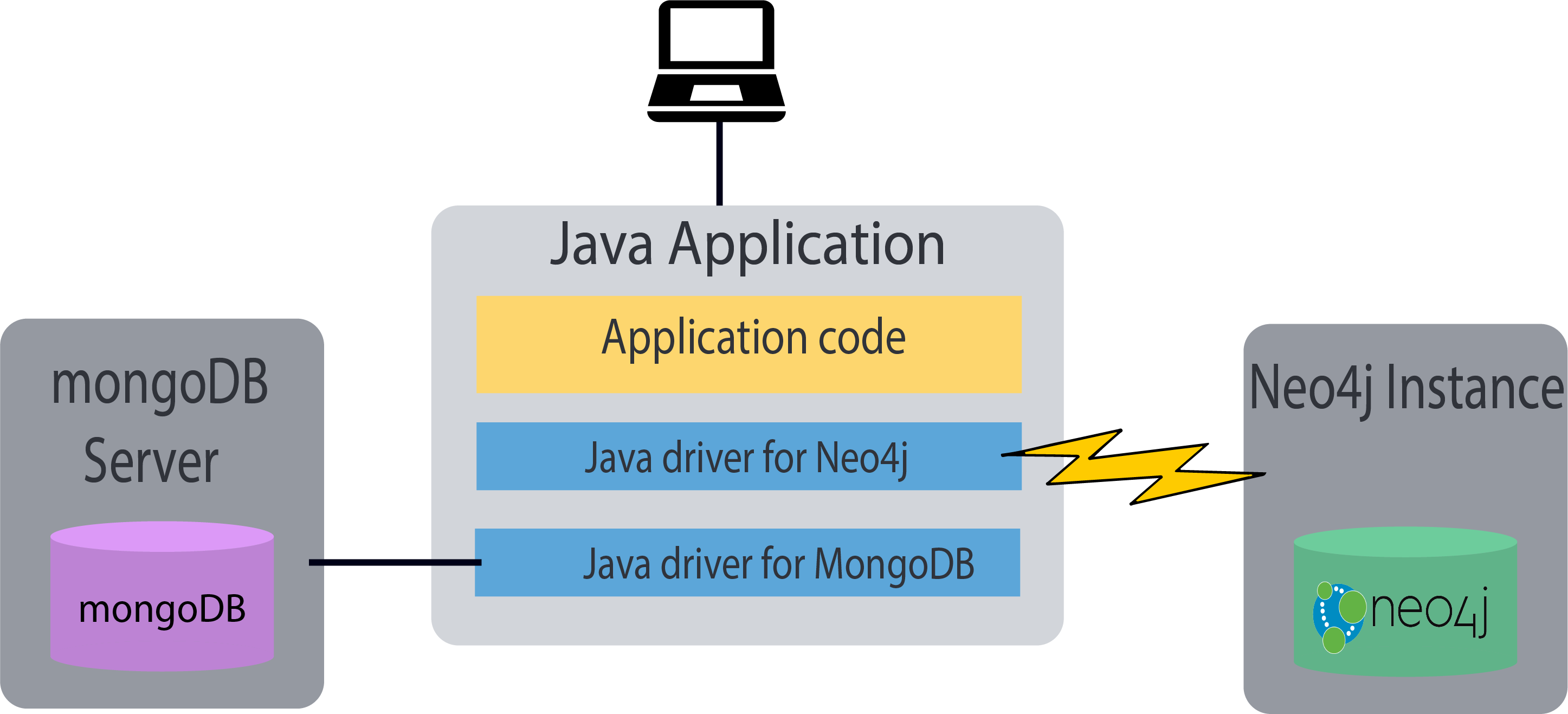
Microservices
With cloud-hosted microservices, the implementation chosen for the microservice is one that performs best for the type of transaction. In a cloud-based microservice architecture, there may be a number of services that Neo4j can provide to the end-users.
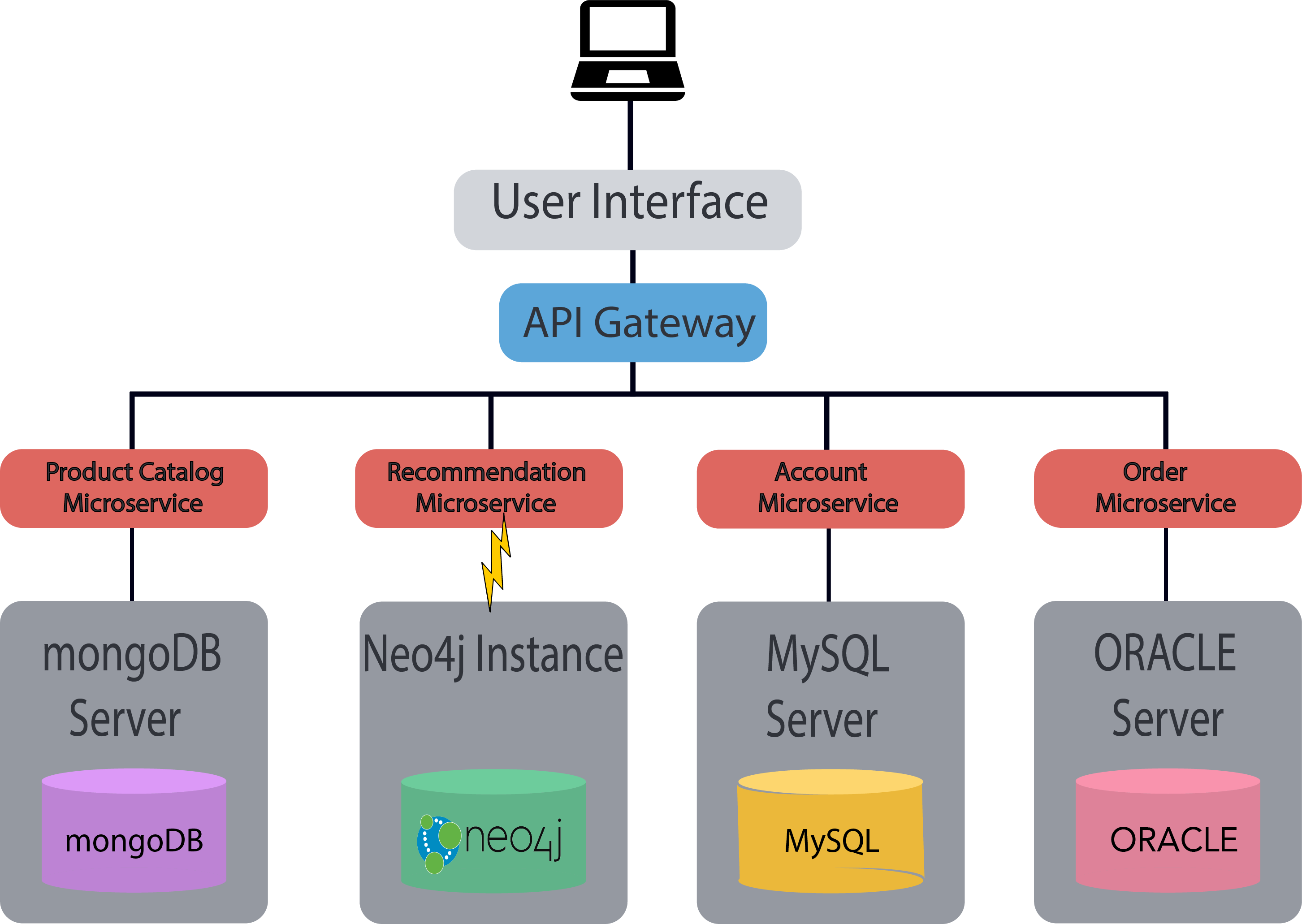
As a Neo4j database administrator, you are responsible for the availability and consistency of the Neo4j database, and for making the data accessible by applications. Application developers are responsible for the logic in transferring and manipulating data between the databases.
Example architecture #3: Using Neo4j Causal Clustering
Causal Clustering is used in production environments where high throughput, continuous availability, and reliability are important factors. This feature is available with Neo4j Enterprise Edition.
With Causal Clusters, you configure multiple Neo4j instances that communicate with each other about updates to the database. Causal Clusters are used when data needs to reside in multiple physical locations, or if you want to implement a high availability architecture where access to data will not be affected if a Neo4j instance goes down.
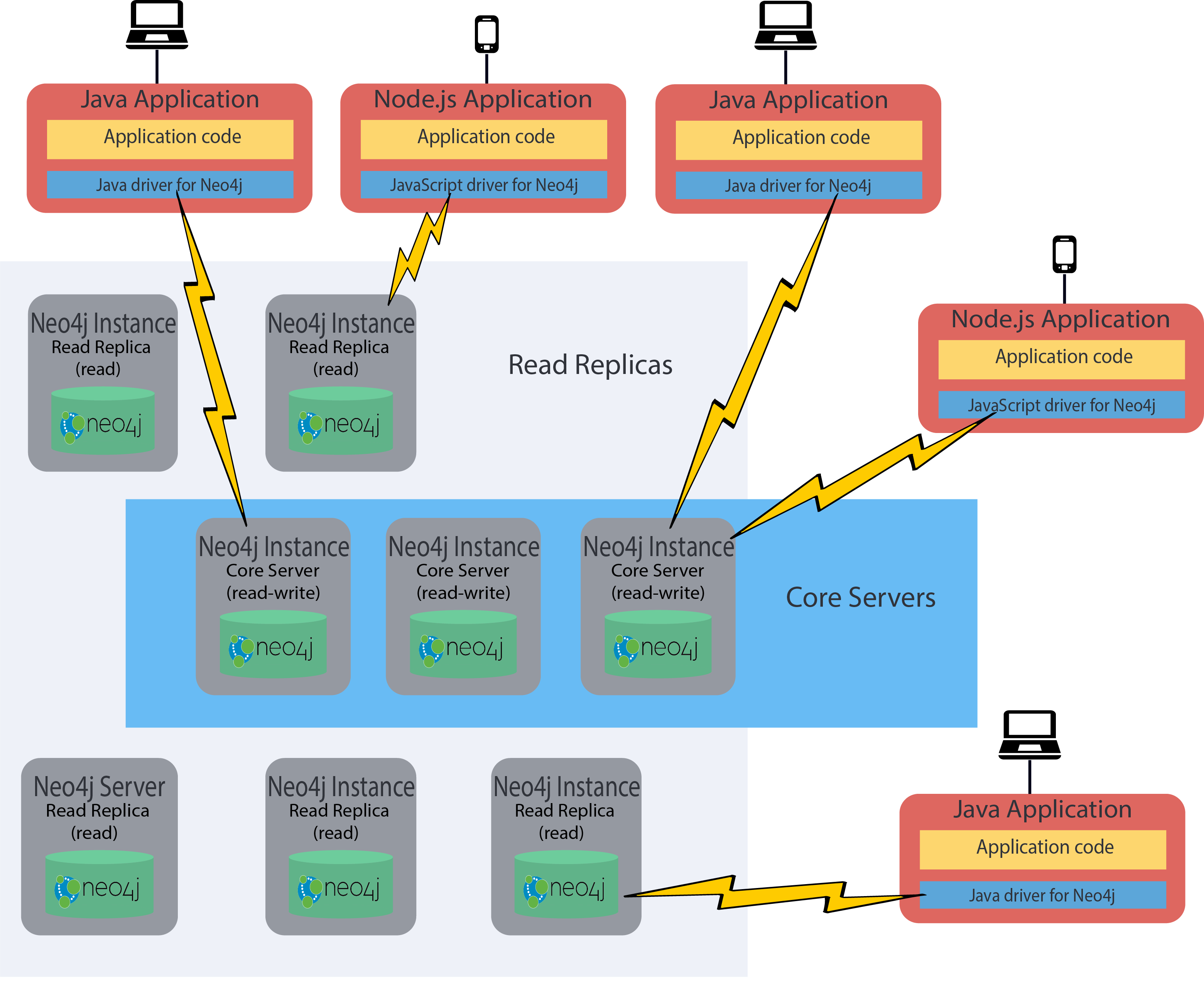
Distributed servers in a cluster
A common use for Neo4j is when different data is required in a set of geographic locations. For example, an online retailer may have different data in the US and Europe. Some data could be shared between different geographically located data centers, but the most heavily updated data needs to physically reside closer to the end-user applications. Neo4j Causal Clusters can be configured to span geographic locations.
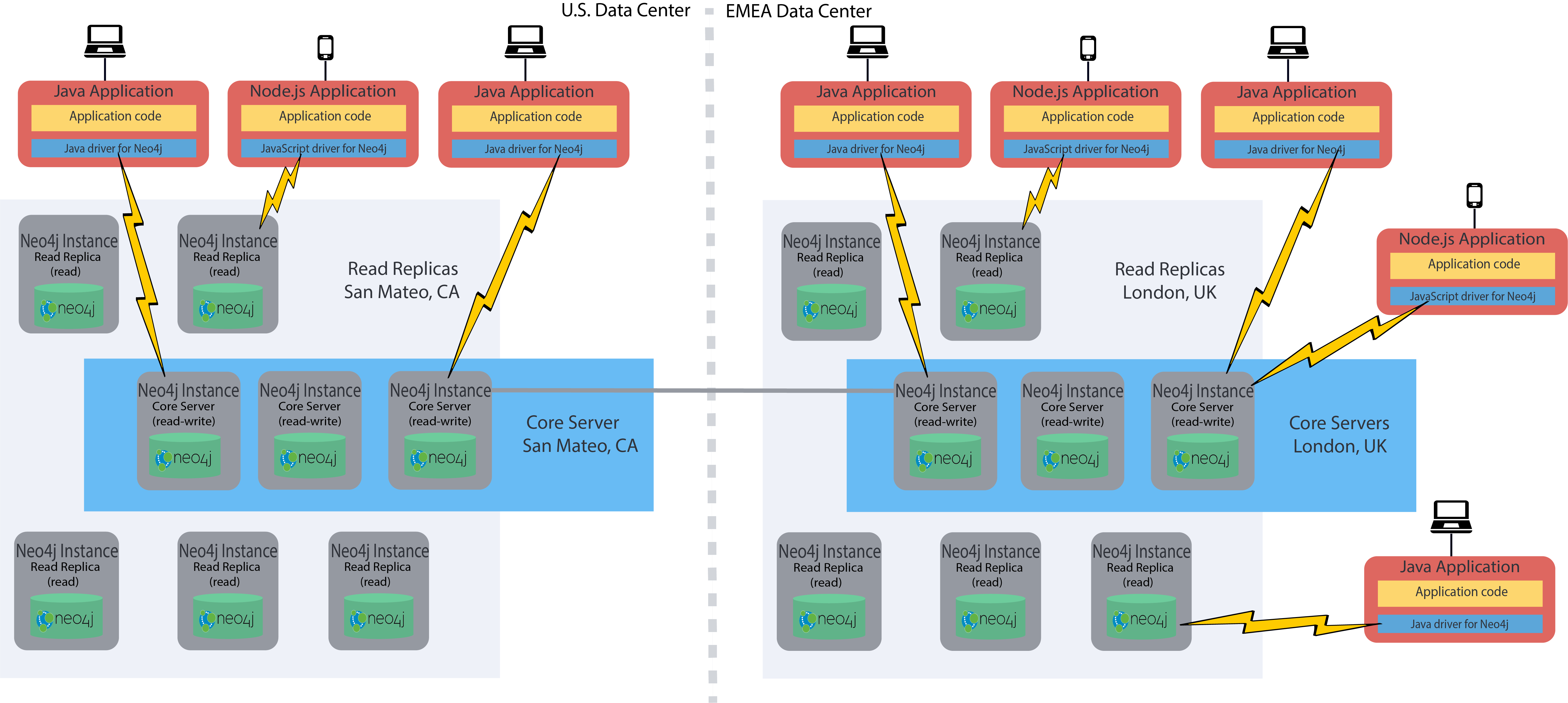
As a Neo4j database administrator, you will be responsible for configuring and monitoring Causal Clusters. You will work with architects to determine the appropriate configuration of the Causal Cluster, taking into account aspects such as: uptime requirements, performance requirements, and redundancy required in order to handle events of Neo4j instance failure or data center failure.
Architecting distributed servers
Some decisions you may need to make are:
-
Number and locations of data centers
-
Number and location of Core Servers and Read Replicas
-
Sizing of servers (hardware and CPU)
-
How to route requests in order to obtain optimal performance
-
Which servers to use as backup servers
We will cover the configuration, management and monitoring of Causal Clusters in depth later in this training.
Example architecture #4: Using Neo4j standalone for graph analytics
A common use case for Neo4j is for data scientists analyze complex patterns in connected data. Neo4j Bloom, or some other data visualization tool, may be used as the front-end. The following are two common patterns this use case:
-
Neo4j is used to find and analyze connections in data from other data sources. To cater for this, the standalone Neo4j database is loaded with data from several sources. As a Neo4j database administrator, you will ensure that the Neo4j database used for this purpose is kept up-to-date and that the data is secure and appropriately backed up.
-
Data scientists analyze the data in a Neo4j production database. In order to safeguard the production database from potentially heavy queries, a dedicated Read Replica is configured (Causal Cluster) . In this case, the analytics database is always up-to-date with the production database, and its administration is a part of the regular Causal Cluster maintenance work (see Example architecture #3).
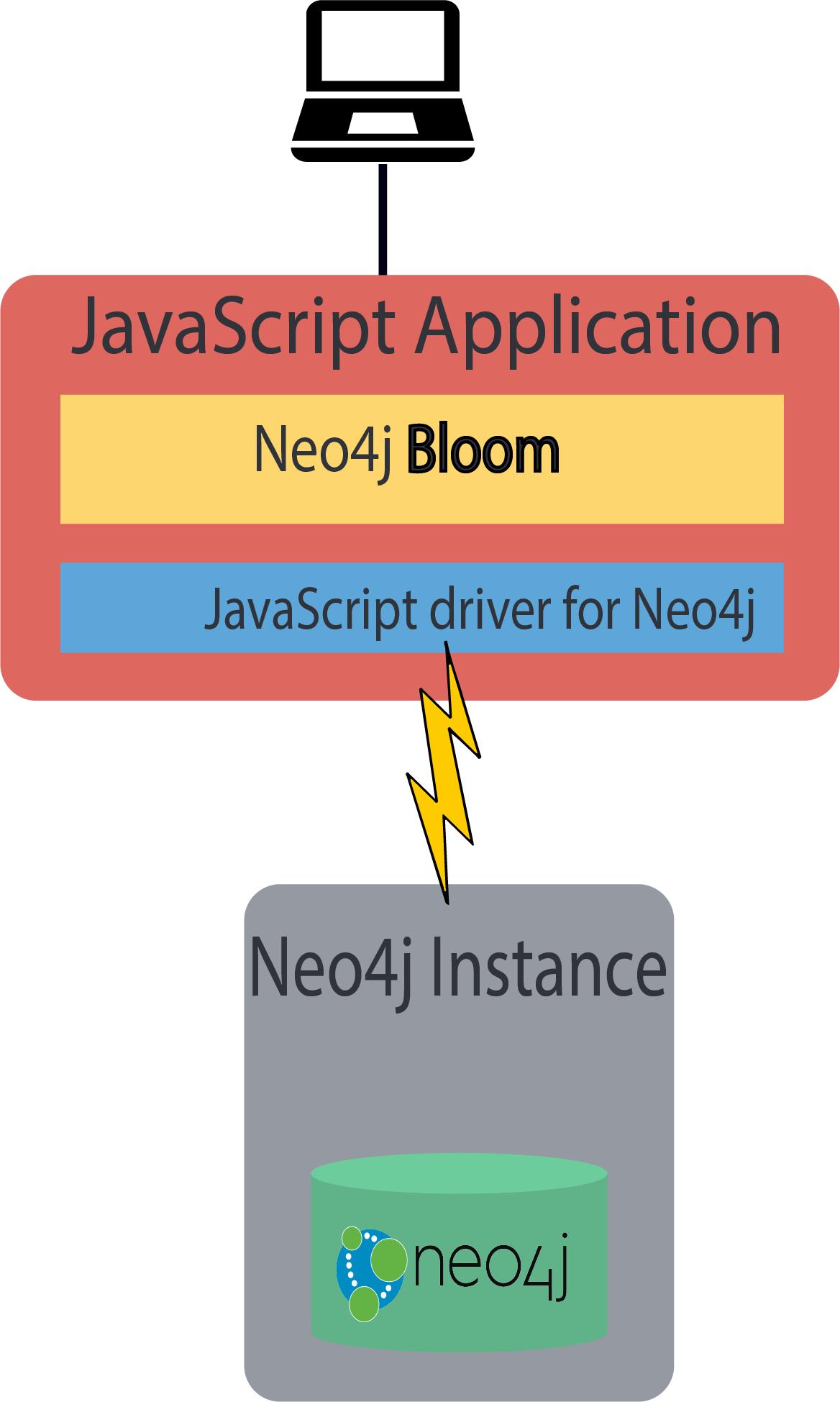
Example architecture #5: Neo4j integrated with compute-heavy solutions
Some enterprises need to consolidate large amounts of data for analysis. The data can come from data lakes, NoSQL databases, document stores, relational, all of which is analyzed and placed into a Neo4j database for analytics. A common architecture for streaming and analyzing data for consolidations is Apache Spark.
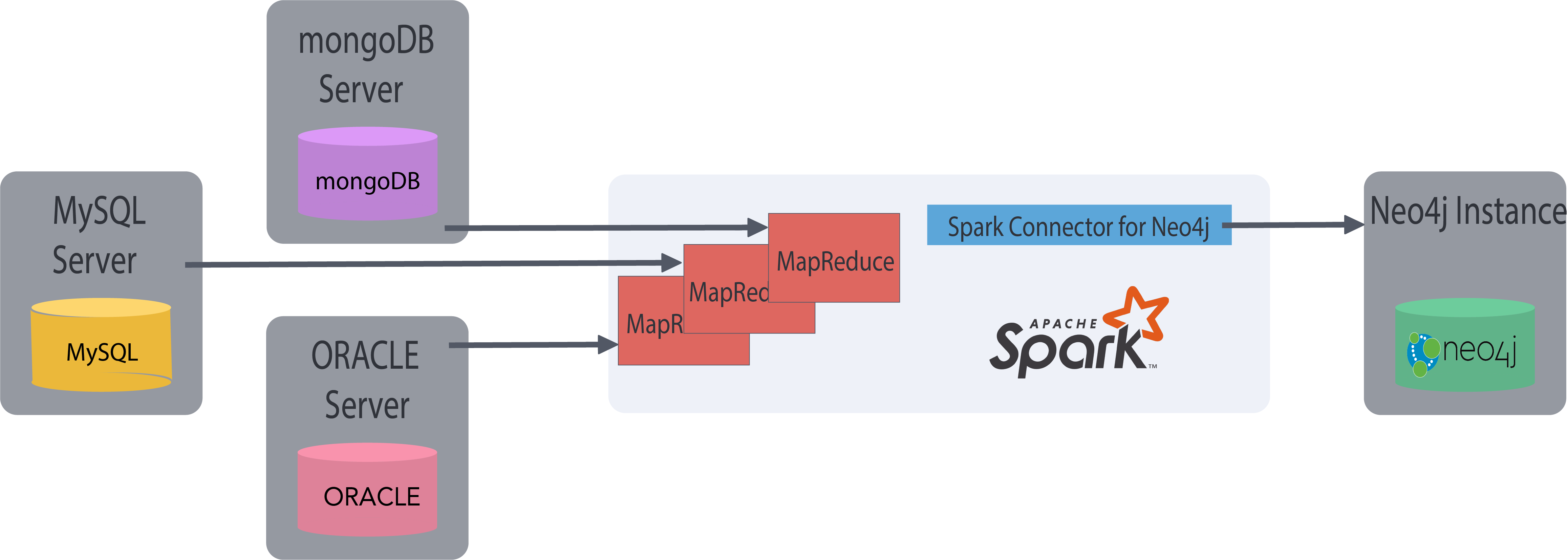
As a Neo4j database administrator, you will work with architects to ensure that the Neo4j database in this type of environment is properly configured and available to the computational engines that will write to the graph.
Neo4j versions
All supported versions of Neo4j are available on the Neo4j download page. On the same page, you can also find pre-releases of the next release. These offer an opportunity to explore coming features. However, it is important to note that functionality in preview releases can be changed without notice. Additionally, the preview releases are not certified for production use.
General Availability releases are our certified releases. They include all features and functionalities intended for that version and supported for production deployments. Production deployments must only use General Availability releases.
| Data migration between non General Availability versions is unsupported. |
Neo4j Editions
There are two versions of Neo4j to choose from: Community Edition and Enterprise Edition. The version you use will depend on the features you require, the nature of your application that uses Neo4j, and the level of professional support you would like to receive from Neo4j.
A full comparison between the Community and Enterprise Editions for the current release of Neo4j can be found at Compare Community and Enterprise Editions.
Community Edition
The Community Edition is a full functioning version of Neo4j suitable for single instance deployments. It has full support for key Neo4j features, such as ACID compliance, Cypher, and access via the binary protocol and HTTP APIs. It is ideal for smaller internal or do-it-yourself projects that do not require high levels of scaling or professional services and support. The Community Edition is free to download and use and is available from the Neo4j download page or from the Neo4j GitHub repository.
Enterprise Edition
The Enterprise Edition extends the functionality of the Community Edition to include key features for performance and scalability such as a clustering architecture for high availability and online backup functionality. It is the right choice for production systems with availability requirements or needs for scaling up or out. Enterprise Edition requires a license from Neo4j. You can download Neo4j Enterprise Edition from the Neo4j download page. When you install Neo4j Enterprise Enterprise, you have a 30 day evaluation license.
Neo4j Desktop
Neo4j Desktop is used by developers who will be deploying their Neo4j applications. It’s purpose is to make development easier by providing access to supported plugins and graph visualization using the Neo4j Browser. The Neo4j instance that runs in Neo4j Desktop is Enterprise Edition so that developers have access to all of the functionality required for developing and testing a production Neo4j application. Developers can install Neo4j Desktop on Linux, OS X, and Windows. Developers can download Neo4j Desktop from the Neo4j download page. Neo4j Desktop is free for developers to use. Developers need to ensure that the version of Neo4j they use for development is the version that will be used in a production environment.
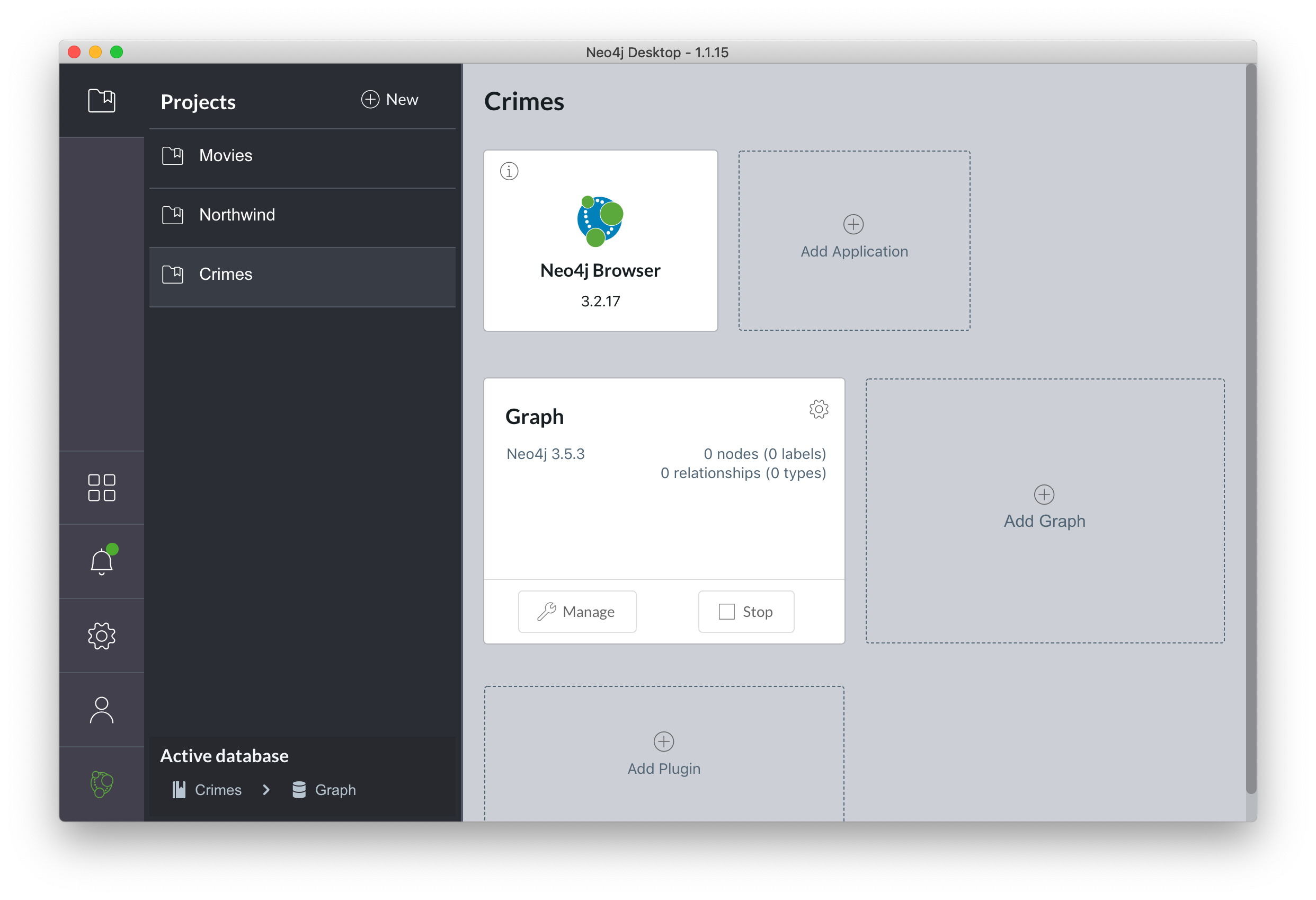
Installing Neo4j
After you have determined which Edition and version of Neo4j you must install for your application, follow the steps outlined in the Neo4j Operations Manual. The instructions include actions that must be taken before installing Neo4j. Later in this training, you will learn how to get started managing and monitoring Neo4j Enterprise Edition.
Upgrading Neo4j
The procedure for upgrading your Neo4j installation will depend upon what release you are upgrading from and to. If you are upgrading to a major release, the upgrade may include a data migration step. The Neo4j Operations Manual provides instructions for upgrading a Neo4j installation.
Supported software and hardware
To install and use Neo4j, the system(s) that host Neo4j Enterprise Edition have specific requirements for:
-
JVM
-
Operating system
-
Hardware architecture
-
Memory
-
Disk
-
Filesystem
Consult the System Requirements to learn more.
Neo4j deployment options
Early in the development of an application, a decision will be made whether to deploy Neo4j instance(s), embedded within the application, or to deploy Neo4j in the Cloud.
Server mode deployments
This is the most common deployment, and it is recommended for all onsite deployments that do not require embedded mode. In this architecture, Neo4j runs as a database server and can be accessed through binary and http APIs for data querying and updating.
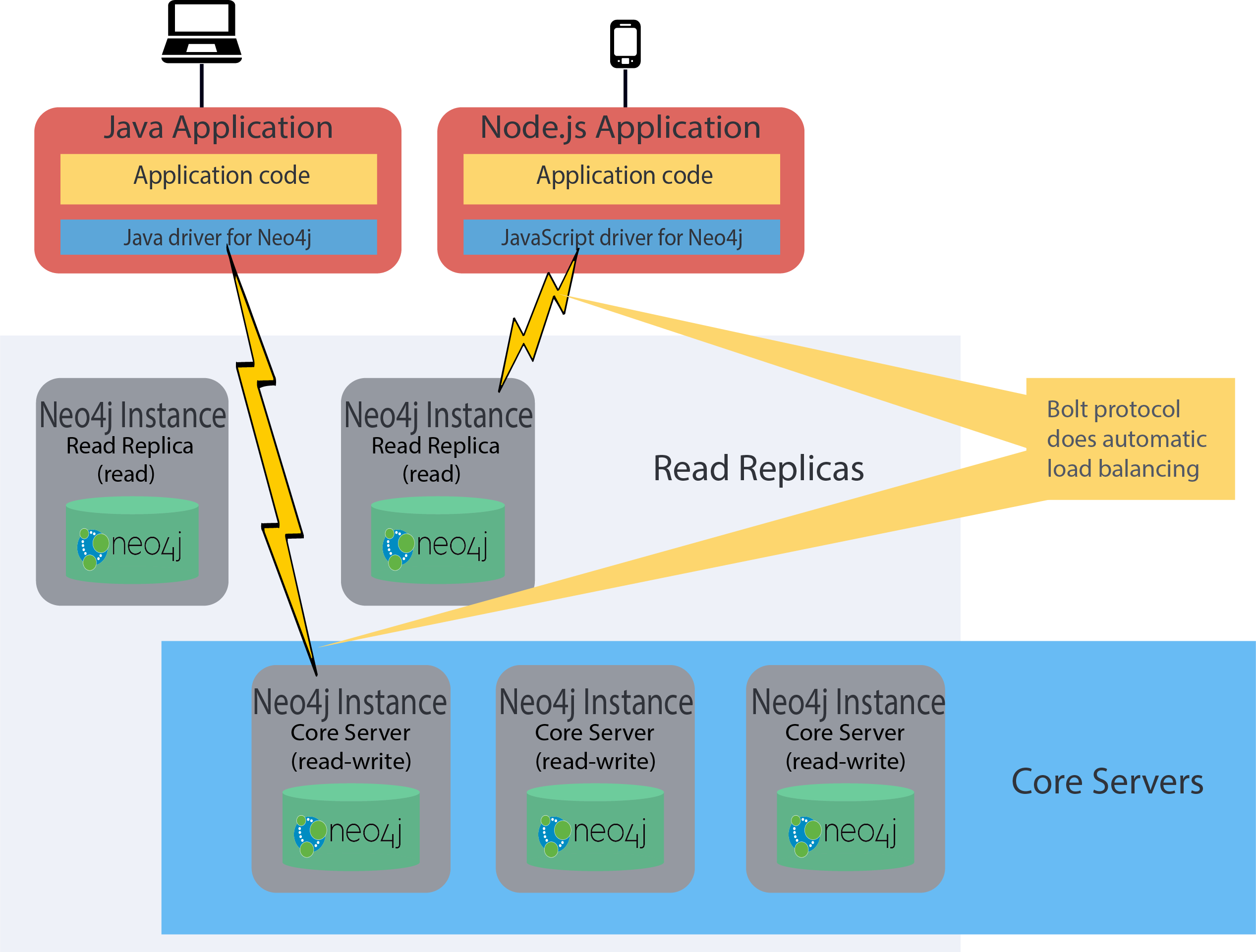
Key advantages of server mode
-
Binary Bolt Protocol or HTTP APIs allows clients to send requests and receive responses over the wire.
-
When using one of the supported drivers together with Causal Clustering, load balancing is provided by Neo4j. It can also be configured to meet specific criteria.
-
Supports Platform independence for the client/application accessing the server APIs due to dedicated language drivers.
-
Can utilize Neo4j and query language extensions via user defined procedures.
-
The database is managed independently from the application.
-
Neo4j instances are easy to configure and provision in production.
Server mode for the Neo4j administrator
When deployed as a server, you will perform many common administration, configuration, and troubleshooting tasks as you would for any database deployment. Neo4j provides utilities and tools for enabling these capabilities, which you will learn about later in this training. This training teaches you about the configuration that will aid you in ensuring a robust and stable deployment.
This training will primarily emphasize the production decisions and administrative tasks associated with a server mode deployment.
Embedded deployments
This architecture is more common in OEM setups, where Neo4j runs integrated as part of a third party product. When Neo4j is embedded directly into an application, you get all the functionality of the database directly accessible through the Java APIs used by the application code. This makes it very easy to directly work with the database and get lightning fast performance.
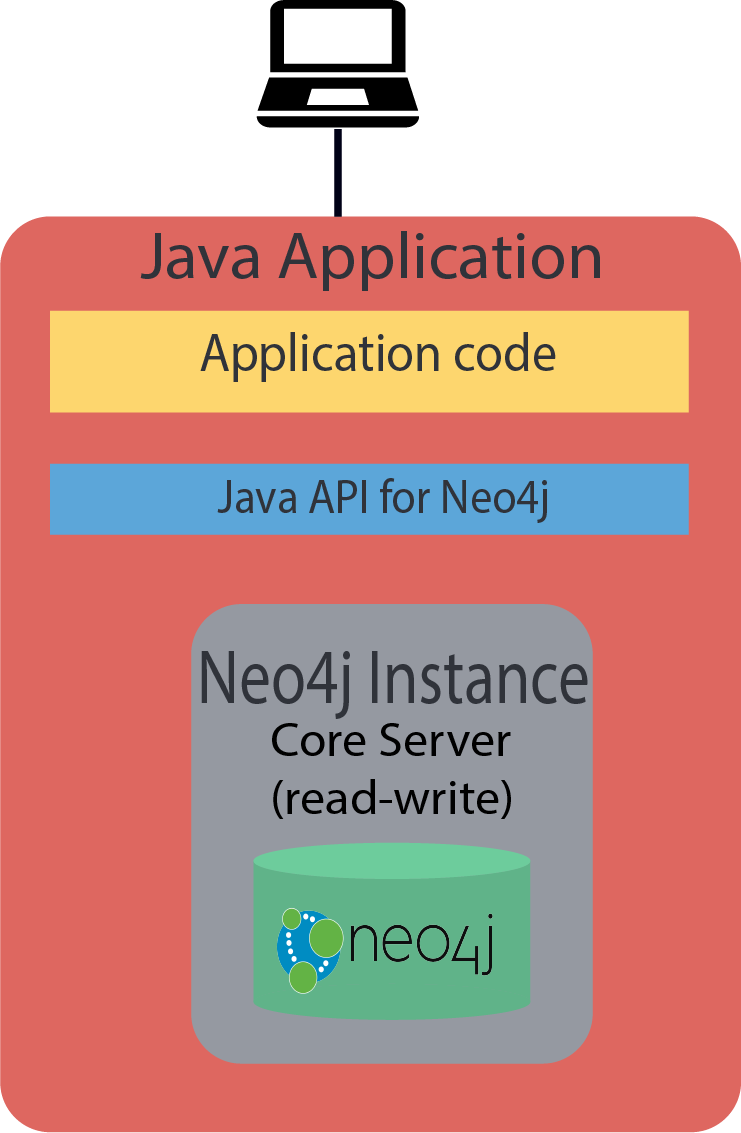
Neo4j in the Cloud
Neo4j has been successfully hosted in these environments:
-
Amazon EC2
-
Google Cloud (GCP)
-
Microsoft Azure
-
Kubernetes
To learn more about Neo4j Cloud deployments see the Developer Guide to Cloud Deployment that is updated regularly.
Administrative tasks for Neo4j
In this training, you will learn how to perform these common administrative tasks for a server mode deployment:
-
Downloading and installing Neo4j
-
Managing a Neo4j database
-
Managing plugins used with the Neo4j database
-
Managing logging
-
Monitoring queries
-
Backing up and restoring databases
-
Managing Causal Clusters
-
Managing database security
Exercise 1: Setting up Neo4j Enterprise Edition on your system
We are using Neo4j Enterprise Edition for the hands-on exercises in this training, as some Neo4j features are not included in Community Edition. Neo4j Enterprise Edition is available for download with a 30 day evaluation license. All screen captures for this training are from an Amazon EC2 Debian instance and will vary from what you experience if you are running on a different platform.
Before you begin
If you have installed Neo4j Desktop on your system, stop any database that is active and shut down Neo4j Desktop. You will be using Enterprise Edition that enables you to perform all common administrative tasks.
Refer to the Neo4j Operations Manual for instructions that are specific to installing Neo4j Enterprise Edition on your platform.
Exercise steps:
1. Except for Debian-based distributions, download Neo4j from the Enterprise Edition download page as follows:
-
Select the latest release of Neo4j Enterprise Edition for your platform.
-
You must provide some identifying information to start your 30 day evaluation.
-
You will receive an email with a link for downloading the software, as well as instructions for installing it on your system.
2. Install Neo4j Enterprise Edition following the instructions for your platform. Ensure that the system requirements are met (specifically, the version of Java required).
3. Confirm that files have been installed as described here.
References
Consult the Neo4J Operations Manual for more information about the installation requirements and procedures for your target platform, as well as details for Neo4j administration tasks.
The Java Developer Manual covers using embedded mode for Neo4j and is intended for developers.
Check your understanding
Question 1
Suppose your organization has two applications that require Neo4j. Each application uses a different Neo4j database and the clients access the database in server mode. For these two databases, how many Neo4j installations are required?
Select the correct answer.
-
one, that will service two databases.
-
two, one Neo4j installation for each database.
-
two, one Core Server, and one Read Replica Server.
-
three, two Core Servers, and one Read Replica Server.
Summary
You can now:
-
Describe common application architectures that use Neo4j.
-
Determine which edition of Neo4j to use.
-
Download a specific Neo4j version.
-
Determine which deployment option to use.
-
Describe the administrative tasks for Neo4j.
-
Install Neo4j Enterprise Edition.
Need help? Ask in the Neo4j Community